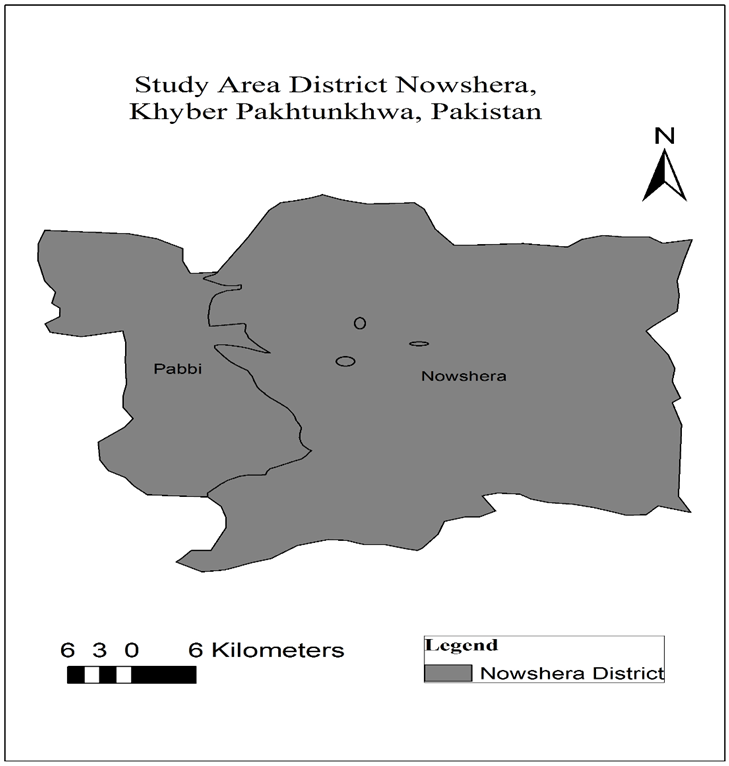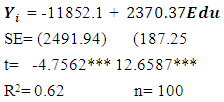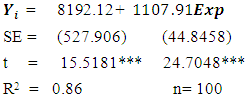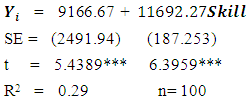-
Paper Information
- Paper Submission
-
Journal Information
- About This Journal
- Editorial Board
- Current Issue
- Archive
- Author Guidelines
- Contact Us
International Journal of Advanced and Multidisciplinary Social Science
2016; 2(1): 27-32
doi:10.5923/j.jamss.20160201.03

The Effects of Education, Experience and Skill on Individuals’ Earning: Empirical Evidence from Khyber Pakhtunkhwa, Pakistan
Shahab e Saqib1, Sanaullah Panezai1, Ubaid Ali2, Muhammad Kaleem3
1Ph.D. Scholar Regional and Rural Development Planning, Asian Institute of Technology, Bangkok, Thailand
2Lecturer in Economics, Higher Education Department, Khyber Pakhtunkhwa, Pakistan
3M.Sc. Economics, Government Post Graduate College Nowshera, Khyber Pakhtunkhwa, Pakistan
Correspondence to: Shahab e Saqib, Ph.D. Scholar Regional and Rural Development Planning, Asian Institute of Technology, Bangkok, Thailand.
| Email: |  |
Copyright © 2016 Scientific & Academic Publishing. All Rights Reserved.
This work is licensed under the Creative Commons Attribution International License (CC BY).
http://creativecommons.org/licenses/by/4.0/

The study aims at testing the Mincer and Becker earning function in the context of Pakistan. This study used a cross-sectional survey design. The micro level data were collected through a questionnaire survey from 100 individuals in Nowshera District, Khyber Pakhtunkhwa. A multi-stage sampling technique was used to select the target population. Through convenient sampling the respondents were interviewed. Simple and multiple regressions were employed to explore the relationship of dependent variable (earnings) with independent variables (education, experience, and skill). Results showed that all the econometric models were good fit. The explanatory variables were significantly explaining the variations in the dependent variable. Education, experience, and skill were the significant variables (at 99% CL) affecting earnings of individuals in separate models. However, skill was found insignificant in the overall model. There is a dire need of occupational knowledge and technical education. The government should take serious actions to promote technical education that would help exterminate unemployment. The future research is recommended to measure the skill of individual as a scale variable to see its more in-depth analysis with earnings.
Keywords: Mincer function, Earnings, Education, Experience, Pakistan
Cite this paper: Shahab e Saqib, Sanaullah Panezai, Ubaid Ali, Muhammad Kaleem, The Effects of Education, Experience and Skill on Individuals’ Earning: Empirical Evidence from Khyber Pakhtunkhwa, Pakistan, International Journal of Advanced and Multidisciplinary Social Science, Vol. 2 No. 1, 2016, pp. 27-32. doi: 10.5923/j.jamss.20160201.03.
Article Outline
1. Introduction
- The relationship between education and economic growth and human capital investment has been the subject of study in economic literature. Education is a key factor of economic growth and poverty reduction. In addition, it is considered as a basic human right. Its development is closely linked with economic, social, and human development. It is also the main factor in improving the quality governance that has a significant positive impact on national income. Spending on education is a process of investment in human capital that generates revenues for the individuals (Nazli, 2004; Chaudhry et al., 2010; Afzal, 2011), and for the economy as a whole (Reza and Valeecha, 2012). Therefore, Pakistan’s investing in the education sector can enhance its economic growth and eradicate poverty.Skill development through education has been identified as a key element of comparative advantage for the socio-economic development. In Pakistan, it has been revealed by one of the studies that that districts with a higher literacy level have a higher level of development (Social Policy Development Center, 2003). For poor people, education can assist as a bulwark against financial instability. Even the basic skills learned in primary school can make a critical difference for the stability of families during economic crises or when government services are not in their reach. The increase in access to education can help to eradicate poverty even before it begins to yield returns in the labor market (Stern, 2001).Pakistan lagged behind the other countries in the education sector. It has not improved the capacity of people to meet the modern world challenges due to lack of investment in education sector. The slower growth of education is a hurdle to economic growth. Pakistan’s educational developments have immensely suffered due to the fragmented system of education. Likewise, other issues such as access, quality and governance are equally responsible for sluggish development. In Pakistan, the primary and secondary school enrolment ratios in 1991 were as low as 46% and 21% respectively. In addition, Pakistan’s gross enrolment ratio is also one of the lowest in the region, particularly in some districts girls’ enrolment rates are very low. Among the South Asian countries, Pakistan lagged behind in enrolment rates, for example, the net primary enrolment rate for Pakistan was 50% against Bangladesh (75%), India (77%) and Sri Lanka (100%) (Hussain, 2003). According to the Human Development Report 2005, in education index, Pakistan scored 0.44, in comparison to India with 0.61 and Bangladesh with 0.45 scores respectively (HDI, 2005). However, the Human Development Index score of Pakistan was 0.527, compared to India with 0.602 and Bangladesh with 0.520 (Shah, 2011). Low level of education combined with lack of technical education skills and low experience, the Pakistan labor market is dominated by unskilled and less educated manpower. Although, since 1980s, a considerable increase in the number of educational institutions has been evidenced from primary to higher levels, but, it has not yet changed the Pakistan’s labor market (Nasir, 2002). There are two important reasons responsible for the failure in producing educated manpower. First is the low government’s investment in education sector. For instance, Pakistan’s expenditures on education is 2% of the GDP (Malik, 2015). Second, majority of the educational institutes emphasize only on academics without developing technical skills (Nasir, 2002). Due to the lethargic demand for the graduates of these academic institutions, the job markets resulted unemployment and the labor market remained dominated by the less educated and less skilled labor. Keeping in view the importance of education and skills, it is important to investigate the role of education, skills and experience in individual earnings and their economic benefits.
1.1. Objectives of the Study
- Ÿ To analyze the effect of education on individual’s income level.Ÿ To analyze the effect of various skills on individual’s income level.Ÿ To analyze the effect of job experience on individual’s income level
1.2. Study Hypotheses
- H11: The higher is the education level, higher will be the income level.H12: A skilled person will have higher income.H13: The person with more job experience earns higher income.
2. Material and Methods
2.1. Selection of the Study Area
- Nowshera District was purposely selected in Khyber Pakhtunkhwa province, Pakistan (Figure 1). The total area of the district is 1748 square kilometers with a population density of 500.2 persons per square kilometer. According to 1998 census, its population is 874,373, of which 52.1% are males and 47.9% are females (Government of Pakistan, 2010). Generally, the people are illiterate and earn living by farming as tenants on land owned by landlords. However, some people are government servants while the others are migrants to the Middle East and other developed countries, from where they send remittances to their families. Besides, a huge population is engaged in the local mills/factories for earning livelihoods.
 | Figure 1. Map of Nowshera District |
2.2. Sample Selection
- According to the census of 1998, the total population in Nowshera District was 874,373. Out of this population, we have dropped the individuals aged 1 to 14 years which stands around 33.3% (Pakistan Demographics Profile, 2014). Therefore, the total working population was 291,166 which included both males and females. We have employed Cochran’s (1977)1 for selection of the sample size.
 | (1) |
 and is ± 1.96.
and is ± 1.96. Error term used for calculate acceptance region and its value is set 0.5. (p)*(q) = Estimates of variance = 0.25 e = Precision value, due to limited resources we have taken “e” value as 0.1 (Naing et al., 2006).
Error term used for calculate acceptance region and its value is set 0.5. (p)*(q) = Estimates of variance = 0.25 e = Precision value, due to limited resources we have taken “e” value as 0.1 (Naing et al., 2006). 2.3. Sampling Procedure
- A multi-stage sampling procedure was used for selection of the sample. At first stage, the Nowshera District was randomly selected. A sample size of 100 households was selected conveniently at three (3) different locations: Qazi Abad, National Colony and Aba Khel. Households were interviewed through questionnaire survey for the data collection.
2.4. Research Design
- This was a cross-sectional study and questionnaire was used to collect the data from individuals. Moreover, this study was an explanatory research that explored the relationship of individual’s earnings with education, skill and experience.
2.5. Selection of the Model
- The study adopted Human Capital Model of Becker (1962) and Mincer (1974) with including skill. While doing so, the following general econometric model was employed.
 | (2) |
 | (3) |
 | (4) |
 | (5) |
 | (6) |
2.6. Study Variables
- Dependent Variable Monthly earning of the respondents is used as dependent variable that is measured in Pakistani Rupees (PKR). Independent VariablesThree independent variables are used in this study that are explained below. 1. EducationEducation of the respondents is one of the explanatory variable used in this study. It is measured in years of schooling or the years studied in madrassa (a religious academic institution).2. Skill Skills include both individual’s formal trainings and informal trainings got from local skilled people. Skill is measured as dummy in our model, where 1= skilled and 0= otherwise. 3. Experience Experience of the respondents is independent variable in our regression model and is measured in number of years the individuals spent in work or jobs for earning livelihood.
3. Results
- The estimated results of equation 3, 4, 5 and 6 are given below. Estimated Results for Equation 4: Relationship between Education and Income
 Note: SE stands for the standard errors, Confidence Levels: ** = 95%, *** = 99%The results obtained from estimation of equation 4 show that overall model is a good fit, 62% of the variations in earnings are explained by education. Likewise, the coefficient of education is also highly significant (99% significance level). The coefficient of education shows that one-year increase in education can increase earnings by PKR. 2370.3. Estimated Results for Equation 5: Relationship between Experience and Income
Note: SE stands for the standard errors, Confidence Levels: ** = 95%, *** = 99%The results obtained from estimation of equation 4 show that overall model is a good fit, 62% of the variations in earnings are explained by education. Likewise, the coefficient of education is also highly significant (99% significance level). The coefficient of education shows that one-year increase in education can increase earnings by PKR. 2370.3. Estimated Results for Equation 5: Relationship between Experience and Income Equation 5 was estimated and results are mentioned in the above model. Experience is found highly significant (99% significance level) factor that affect earnings of individuals. The coefficient of experience shows that a one-year increase in experience can increase earnings by PKR. 1107.91. The coefficient of determination is very high that shows the fitness of the model, for example, experience explains 88% of the variation in earnings. Estimated Results for Equation 6: Relationship between Skill and Income
Equation 5 was estimated and results are mentioned in the above model. Experience is found highly significant (99% significance level) factor that affect earnings of individuals. The coefficient of experience shows that a one-year increase in experience can increase earnings by PKR. 1107.91. The coefficient of determination is very high that shows the fitness of the model, for example, experience explains 88% of the variation in earnings. Estimated Results for Equation 6: Relationship between Skill and Income The estimated results of equation 6 shows that skill is an important factor of earning. It was found significant (99% significance level) shown by its t value=6.3959. The coefficient of education shows that if the value of skill dummy is changed from 0 to 1 it can increase earnings by PKR. 1169.27. The coefficient of determination is not very high; however, it is still satisfactory because 29% of the variation in earnings is explained by skill.Results for Equation 3: Combined Estimated Model
The estimated results of equation 6 shows that skill is an important factor of earning. It was found significant (99% significance level) shown by its t value=6.3959. The coefficient of education shows that if the value of skill dummy is changed from 0 to 1 it can increase earnings by PKR. 1169.27. The coefficient of determination is not very high; however, it is still satisfactory because 29% of the variation in earnings is explained by skill.Results for Equation 3: Combined Estimated Model  The above results are obtained after estimation of equation 3 which is the overall model; combining all three explanatory variables. Results show that overall model is highly significant as its coefficient of determination is 0.88. In the above model, education and experience are found highly significant factors that affect earnings of individuals. The coefficient for education shows that a unit increase, keeping other variables constant, cause an increase in earning by PKR. 563.94. Similarly, a unit increase in experience cause an increase in earning by PKR. 899.59. Unlike education and experience, skill is found an insignificant factor in the combined model of earning function.
The above results are obtained after estimation of equation 3 which is the overall model; combining all three explanatory variables. Results show that overall model is highly significant as its coefficient of determination is 0.88. In the above model, education and experience are found highly significant factors that affect earnings of individuals. The coefficient for education shows that a unit increase, keeping other variables constant, cause an increase in earning by PKR. 563.94. Similarly, a unit increase in experience cause an increase in earning by PKR. 899.59. Unlike education and experience, skill is found an insignificant factor in the combined model of earning function. 4. Discussion
- Since 1960s, in the debate of economics of education, the role of education and human capital in earning of individuals has been a prominent issue. Education in our model was significantly and positively affecting earnings of individuals both in separate and overall model. Our findings regarding education confirms the findings of Kingdon and Söderbom (2007), Chaudhry et al. (2010), Mussagy and Babatunde (2015), Nazli (2004), Reza and Valeecha (2012), Malik (2015), Shah (2011), Farooq (2011) and Peet et al. (2015). They have found that at micro level, education had significant and positive relationship with individual earning, similarly, at macro level it had positive and significant relationship with GDP. Some other studies such as; Hamdani (1977), Khan et al. (1985), Ahmed and Slrageldin (1994) and Ashraf et al. (1993) were also supported by our findings. They estimated the earning functions by defining the dummy variables for different levels of education. Their studies observed low rates of returns at different levels of education as compared to other developing countries. However, they have also noted a positive association between levels of education and earnings and an inverse relationship between the degree of income inequality and educational attainment. Experience is playing a significant role in individual earnings both in the overall model as well as separate model. Experience was found significant factor according to our findings in this study. The findings of this study are in accordance with the findings of Afzal (2011), Peet et al. (2015), Farooq (2011) and Shah (2011). Their studies have revealed that earnings of individuals are significantly affected by their experience. Regarding skills, our findings show that skill of individual is significantly affecting the earnings in separate model, however, it was not found significant in the overall model. Our findings in the overall model, are in disagreement with the findings of Kingdon and Söderbom (2007), Nazli (2004), Nasir (2002) and Afzal (2011). The reason behind the insignificance of this indicator that didn’t support the previous studies might be due to the different measuring criteria of skills used in this study (the use of dummy). As stated earlier, the hypothesis for this study was to test the validity of Mincer function in the context of Pakistan. It is revealed that education and experience are significantly affecting earnings of individuals in the study area. However, skills in overall models were not significantly affecting earnings.
5. Conclusions
- The study discovered the importance of education in individual’s earnings. Educated individuals were earning more than illiterate counterparts. Similarly, skills and experience are also very important factors that can enhance earnings and eradicate poverty in a society. The findings of the study suggest that, an immediate attention should be paid for enhancing literacy and numeracy skills through the promotion of formal as well as informal education. In order to minimize the wastage of public spending in education, the resources should be optimally utilized by diverting them to more effective and efficient modes of education. There is a strong need of occupational knowledge and technical education. The government should take serious actions to promote technical education to improve earnings and exterminate unemployment. The future research is recommended to measure skills of individual as a scale variable to see its more in-depth analysis with earnings.
ACKNOWLEDGMENTS
- The authors extend thanks to the two anonymous reviewers for their invaluable comments and suggestions that have substantially improved the quality of the manuscript.
Note
- 1. Organizational Research: Determining Appropriate Sample Size in Survey Research: James E. Bartlett, Joe W. Kotrlik, Chadwick C. Higgins (2001)
 Abstract
Abstract Reference
Reference Full-Text PDF
Full-Text PDF Full-text HTML
Full-text HTML